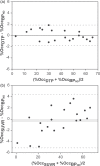Dual time-point imaging for post-dose binding potential estimation applied to a [11C]raclopride PET dose occupancy study
- PMID: 27073203
- PMCID: PMC5363466
- DOI: 10.1177/0271678X16644463
Dual time-point imaging for post-dose binding potential estimation applied to a [11C]raclopride PET dose occupancy study
Abstract
Receptor occupancy studies performed with PET often require time-consuming dynamic imaging for baseline and post-dose scans. Shorter protocol approximations based on standard uptake value ratios have been proposed. However, such methods depend on the time-point chosen for the quantification and often lead to overestimation and bias. The aim of this study was to develop a shorter protocol for the quantification of post-dose scans using a dual time-point approximation, which employs kinetic parameters from the baseline scan. Dual time-point was evaluated for a [11C]raclopride PET dose occupancy study with the D2 antagonist JNJ-37822681, obtaining estimates for binding potential and receptor occupancy. Results were compared to standard simplified reference tissue model and standard uptake value ratios-based estimates. Linear regression and Bland-Altman analysis demonstrated excellent correlation and agreement between dual time-point and the standard simplified reference tissue model approach. Moreover, the stability of dual time-point-based estimates is shown to be independent of the time-point chosen for quantification. Therefore, a dual time-point imaging protocol can be applied to post-dose [11C]raclopride PET scans, resulting in a significant reduction in total acquisition time while maintaining accuracy in the quantification of both the binding potential and the receptor occupancy.
Keywords: Dual time-point; [11C]raclopride; binding potential; positron emission tomography; quantification.
Figures





Similar articles
-
D₂-receptor occupancy measurement of JNJ-37822681, a novel fast off-rate D₂-receptor antagonist, in healthy subjects using positron emission tomography: single dose versus steady state and dose selection.Psychopharmacology (Berl). 2012 Dec;224(4):549-57. doi: 10.1007/s00213-012-2782-1. Epub 2012 Jul 7. Psychopharmacology (Berl). 2012. PMID: 22773165 Clinical Trial.
-
Error analysis for PET measurement of dopamine D2 receptor occupancy by antipsychotics with [11C]raclopride and [11C]FLB 457.Neuroimage. 2008 Oct 1;42(4):1285-94. doi: 10.1016/j.neuroimage.2008.05.056. Epub 2008 Jun 10. Neuroimage. 2008. PMID: 18585466
-
In vivo quantification of striatal dopamine D2 receptor occupancy by JNJ-37822681 using [11C]raclopride and positron emission tomography.J Psychopharmacol. 2012 Aug;26(8):1128-35. doi: 10.1177/0269881111435251. Epub 2012 Jan 30. J Psychopharmacol. 2012. PMID: 22290934
-
Dopamine D(2/3) receptor occupancy of apomorphine in the nonhuman primate brain--a comparative PET study with [11C]raclopride and [11C]MNPA.Synapse. 2009 May;63(5):378-89. doi: 10.1002/syn.20615. Synapse. 2009. PMID: 19173265
-
Within-subject comparison of striatal D2 receptor occupancy measurements using [123I]IBZM SPECT and [11C]Raclopride PET.Neuroimage. 2009 Jun;46(2):447-58. doi: 10.1016/j.neuroimage.2009.02.005. Epub 2009 Feb 20. Neuroimage. 2009. PMID: 19233294
Cited by
-
A dual-time-window protocol to reduce acquisition time of dynamic tau PET imaging using [18F]MK-6240.EJNMMI Res. 2021 May 27;11(1):49. doi: 10.1186/s13550-021-00790-x. EJNMMI Res. 2021. PMID: 34046730 Free PMC article.
References
-
- Matthews PM, Rabiner I, Gunn R. Non-invasive imaging in experimental medicine for drug development. Curr Opin Pharmacol 2011; 11: 501–507. - PubMed
-
- Waarde AV. Measuring receptor occupancy with PET. Curr Pharm Des 2000; 6: 1593–1610. - PubMed
-
- Innis RB, Cunningham VJ, Delforge J, et al. Consensus nomenclature for in vivo imaging of reversibly binding radioligands. J Cereb Blood Flow & Metab 2007; 27: 1533–1539. - PubMed
-
- Willemsen ATMW and Paans AMJ. An introduction to kinetic modeling and quantification and its role in drug development. In: Trends on the role of PET in drug development. Singapore: World Scientific Publishing, 2012, pp.417–454.
-
- Logan J, Fowler JS, Volkow ND, et al. Distribution volume ratios without blood sampling from graphical analysis of PET data. J Cereb Blood Flow Metab 1996; 16: 834–840. - PubMed
MeSH terms
Substances
LinkOut - more resources
Full Text Sources
Other Literature Sources

